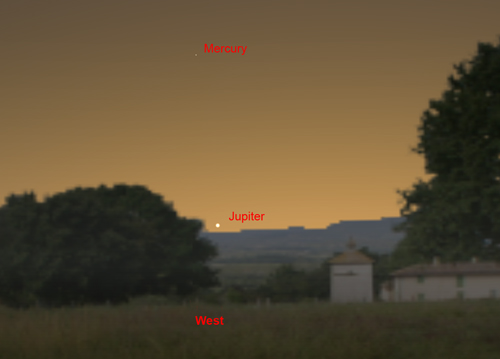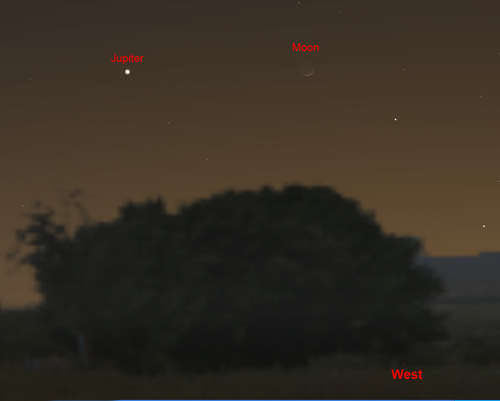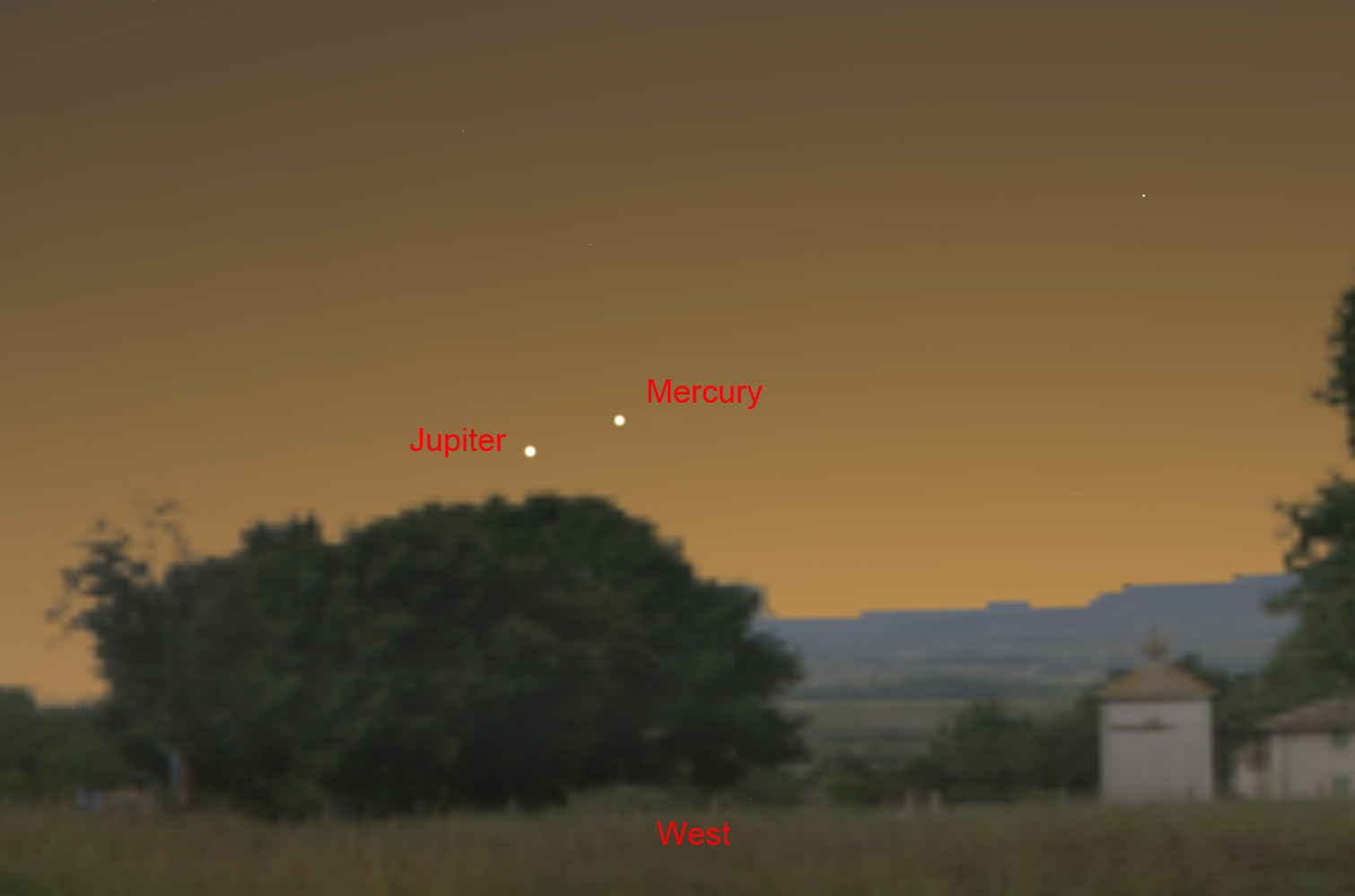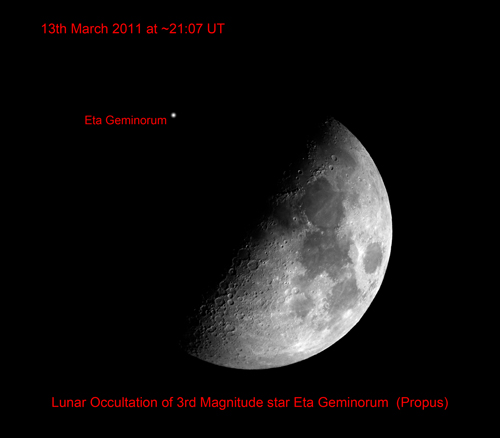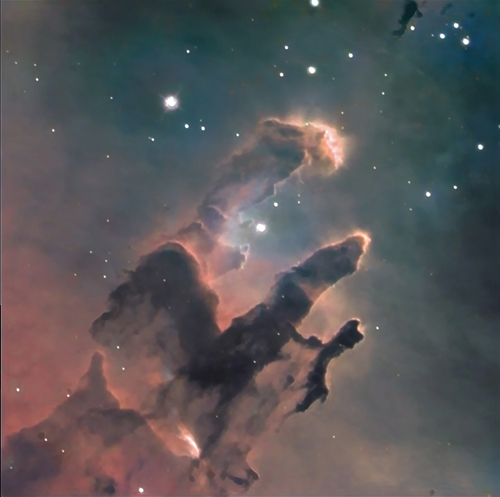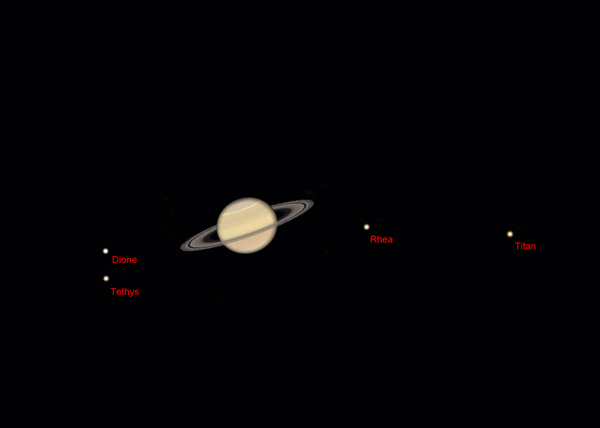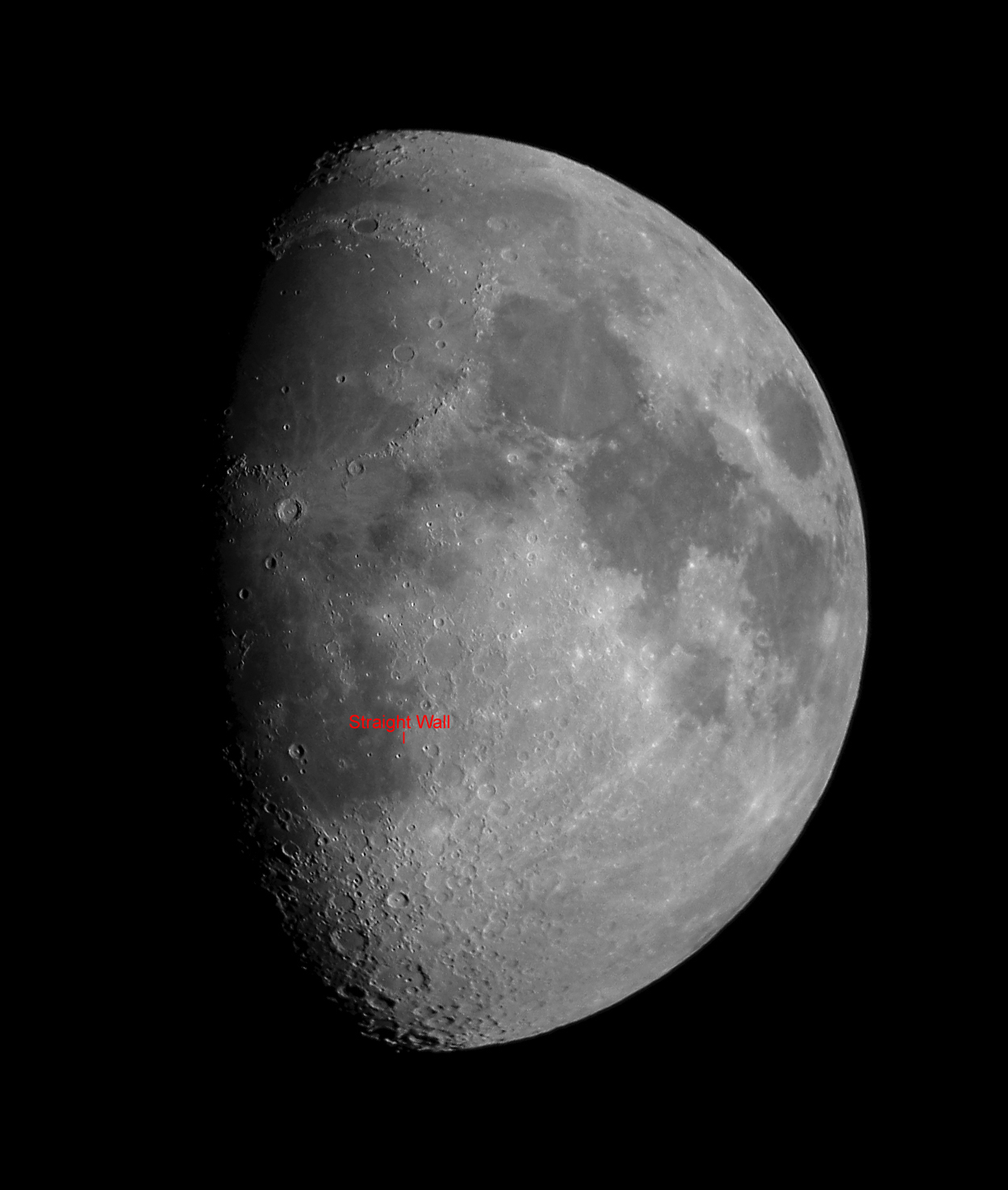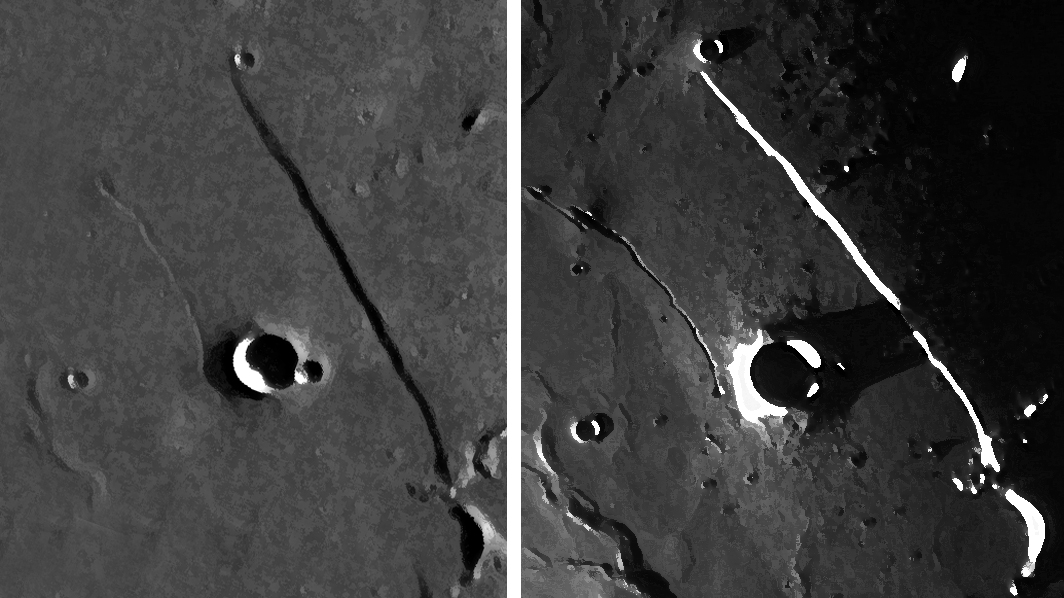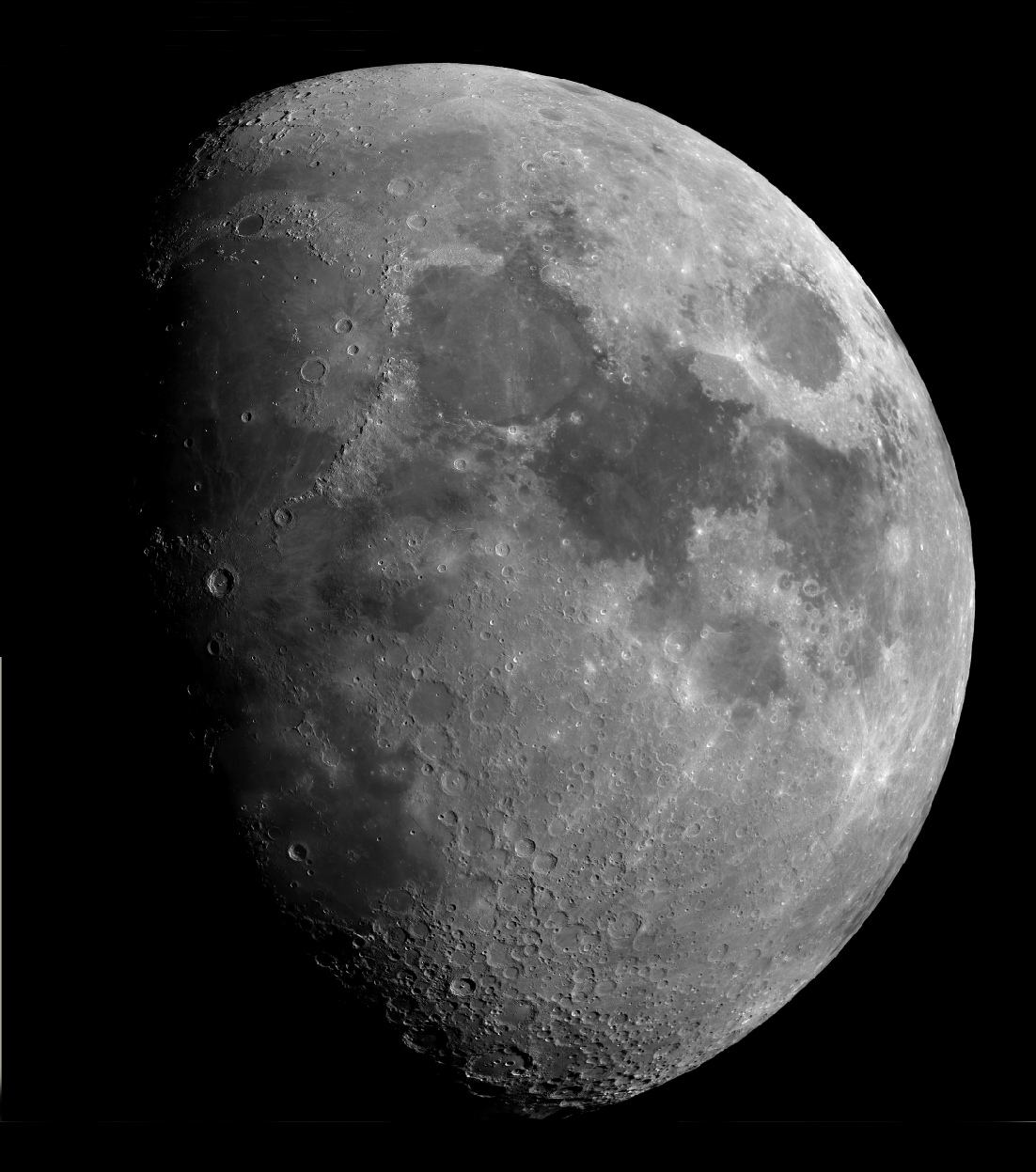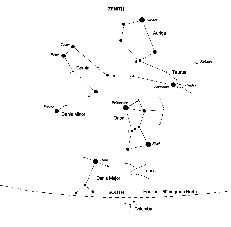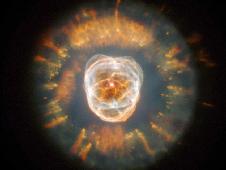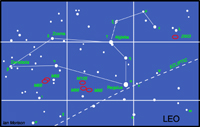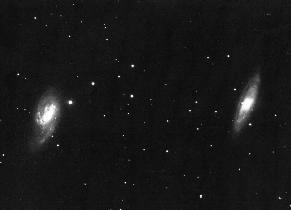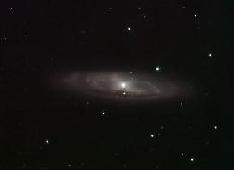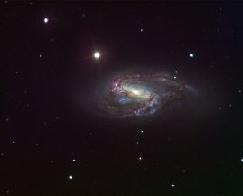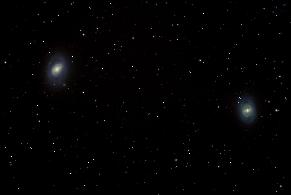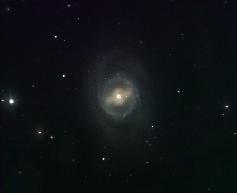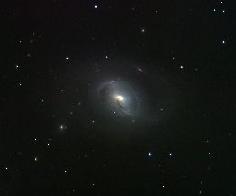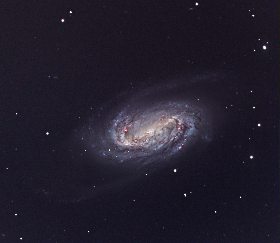The Night Sky March 2011
Compiled by Ian Morison
This page, updated monthly, will let you know some of the things that you can look out for in the night sky. It lists the phases of the Moon, where you will see the naked-eye planets and describes some of the prominent constellations in the night sky during the month.
The British Astronomical Association and the Macclesfield Astronomical Society are holding a Beginner's Day on Saturday March 6th at Macclesfield Town Hall.
Click here for more information:
BAA and MAS Beginner's Day: Macc Astro Website"
Image of the Month
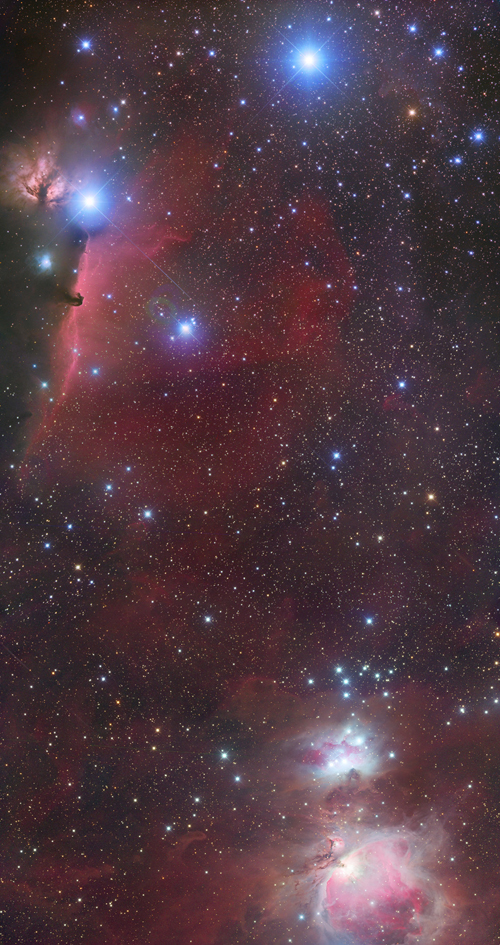
The Sword of Orion M31 imaged by Peter Shah.
Copyright Peter Shah.
This is one of the most beautiful images of the Sword of Orion of that I have ever seen. It was imaged by Peter Shah from his observatory in Shropshire using an 8", f3.8, "Advanced Astrograph" telescope built by Orion Optics in Crewe, Cheshire. At the top are two of the three stars that make up Orion's belt. Below the lower left star, Zeta Orionis, is the "Horsehead Nebula - a dark dust cloud that is seen against the emission from excited hydrogen. Towards the bottom is, M42, the Orion Nebula lit by the light from the bright blue stars forming the "trapesium" at its heart. Please visit Peter's website to see more of his stunning images!
Visit Peter Shah' website to learn about his equipment and view the images that he has made: Peter Shah's Website"
Highlights of the Month
Mercury at its best this spring
In the evening around the time of the spring equinox, the ecliptic lies at quite a steep angle to the western horizon. This means that it is the best time to view an evening apparition of the planet Mercury. It becomes just visible around the 5th of March shining at a magnitude of -1.4 close above the western horizon - just a touch south of west - and setting about 40 minutes after the Sun. You will need a very good low western horizon to spot it then! That evening, a very thin crescent Moon will lie 5 degrees 45 minutes up to its right - that would be pretty good to spot! But as the month progresses, it increases its angular separation from the Sun, so will be seen higher in the sky after sunset. Its greatest eastern elongation - when it is furthest in angle from the Sun - is on the 23rd March, but, by then, its brightness will have dropped to magnitude +0.4. It will lie 9.3 degrees directly below a very thin waxing crescent Moon on the 6th. Probably the best time to look for it is around the 15th March as highlighted below. On the 23rd, you might just spot Jupiter directly below just above the horizon.
After sunset March 6th: Jupiter and a thin cresent Moon lie above Mercury
After sunset on the 6th March you should, if clear, be able to see Jupiter just to the left of a very thin crescent Moon which lies ~9 degrees above the planet Mercury (which may be too low to see unless you have a very good flat western horizon). But do not try to observe until the Sun has set!
After sunset March 15th: A close encounter of Jupiter and Mercury
After sunset on the 15th March you should, if clear, be able to spot Mercury just up and to the right of Jupiter - a fraction under 2 degrees away - so both would be visible together in binoculars or a small telescope. But do not try to observe until the Sun has set!
Evening of the 13th March: See the Moon occult a star.
Lunar occultationAt ~21:07 UT on the evening of Feb 13th, the ~3rd magnitude star Eta Geminorum will be occulted by the leading (and dark) limb of the Moon. Binoculars would be fine to see the star apparently disappear in the twinkling of an eye - so try to judge when this will happen by imagining the Moon's complete disk. It will reappear equally quickly an hour later at ~22:07. The times vary somewhat across the UK.
A Messier Object imaged with the Faulkes Telescope: Messier 16 - The Eagle Nebula
The Eagle Nebula, M16, imaged by Nik Szymanek.
This image was taken using the Faulkes Telescope North by Nik Szymanek - one of the UK's leading astro-photograpers. M16 is also called the Eagle Nebula due to its resemblence to an eagle - it even has a fish in its tallons! It lies about 7000 light years from the Earth in the constellation Serpens. It is a star formation region with the pinky-red colour due to hydrogen excited by the ultraviolet light from the young stars in the nebula. The stars ages range from ~1 to ~5.5 million years old. The longest of the pillars is about 7 light years in length - it is in these pillars of dust that new stars are forming.
Learn more about the Faulkes Telescopes and how schools can use them: Faulkes Telescope"
March 1st/2nd :Midnight: Observe Saturn's Moons
Its easy to spot Titan, Saturn's brightest moon at 8th magnitude - you should be able to do this with binoculars on a dark transparent night away from Full Moon. But given a 6 inch or greater aperture telescope its worth looking for three further satellites: Dione, Rhea and Tethys. Midnight between the 1st and 2nd March is ideal as there is no Moon and Titan and the three 10th magnitude moons are seen close by Saturn so a reasonably high power eyepiece can be used. Well worth a look if you have a suitable telescope. You can obviously look for them at any other time when the Moon does not intrude. The free software program "Stellarium" (just put into Google) will show you where they will be seen.
March 13th and 25th: The Straight Wall
The Straight Wall
The Straight Wall is best observed either 1 or 2 days after First Quarter (13th March) or a day or so before Third Quarter (26th March). To be honest, it is not really a wall but a gentle scarp - as Sir Patrick has said "Neither is it a wall nor is it straight!".
Observe the International Space Station

The International Space Station and Jules Verne passing behind the Lovell Telescope on April 1st 2008.
Image by Andrew Greenwood
Use the link below to find when the space station will be visible in the next few days. In general, the space station can be seen either in the hour or so before dawn or the hour or so after sunset - this is because it is dark and yet the Sun is not too far below the horizon so that it can light up the space station. As the orbit only just gets up the the latitude of the UK it will usually be seen to the south, and is only visible for a minute or so at each sighting. Note that as it is in low-earth orbit the sighting details vary quite considerably across the UK. The NASA website linked to below gives details for several cities in the UK. (Across the world too for foreign visitors to this web page.)
Note: I observed the ISS three times recently and was amazed as to how bright it has become.
Find details of sighting possibilities from your location from: Location Index
See where the space station is now: Current Position
The Moon

The Moon at 3rd Quarter. Image, by Ian Morison, taken with a 150mm Maksutov-Newtonian and Canon G7.
Just below the crator Plato seen near the top of the image is the mountain "Mons Piton". It casts a long shadow across the maria from which one can calculate its height - about 6800ft or 2250m.
| new moon | first quarter | full moon | last quarter |
|---|---|---|---|
| March 4th | March 12th | March 19th | March 26th |
Some Lunar Images by Ian Morison, Jodrell Bank Observatory: Lunar Images
A World Record Lunar Image
To mark International Year of Astronomy, a team of british astronomers have made the largest lunar image in history and gained a place in the Guinness Book of Records! The whole image comprises 87.4 megapixels with a Moon diameter of 9550 pixels. This allows details as small as 1km across to be discerned! The superb quality of the image is shown by the detail below of Plato and the Alpine Valley. Craterlets are seen on the floor of Plato and the rille along the centre of the Alpine valley is clearly visible. The image quality is staggering! The team of Damian Peach, Pete lawrence, Dave Tyler, Bruce Kingsley, Nick Smith, Nick Howes, Trevor Little, David Mason, Mark and Lee Irvine with technical support from Ninian Boyle captured the video sequences from which 288 individual mozaic panes were produced. These were then stitched together to form the lunar image.
Please follow the link to the Lunar World Record website and it would be really great if you could donate to Sir Patrick Moore's chosen charity to either download a full resolution image or purchase a print.
The Planets
Jupiter
Jupiter. Jupiter, at magnitude -2.1, is now coming towards the end of its current apparition but can still be seen low in the west after sunset at the beginning of March. By month's end it will have been swallowed up in evening twilight so this is our last chance to observe it for several months as it passes behind the Sun. Its angular size is ~33.5 arc seconds so is still worth observing with a telescope. Jupiter, having lost its South Equatorial Belt last year is now showing it again though it is still not that prominent. At the same time, the Great Red Spot has intensified its colour so is now standing out very well! A small telescope will easily pick up Jupiter's four Galilean moons as they weave their way around it. The thin waxing crescent Moon passes close to Jupiter on the 6th of the month.
See Highlight above.
Saturn
Saturn. Saturn is becoming an evening object rising at ~21:00 UT at the beginning of the March and 20:00 UT by month's end. It will be due south, and hence highest in the sky, at 3:00 UT at the beginning of the month but by 01:00 BST by its end. It starts March with a magnitude of +0.5 and, ss the month progresses, its brightness increases a touch to +0.4. Compared to last year, its apparent brightness hasnow increased the rings have opened out again - now tilted +9 degrees degrees from edge on.(Though, due to the changing aspect from our moving viewpoint, they are slightly less open than a few months ago.) The plus sign indicates that we are seeing Saturn's north pole. They span an angular size of 42 arc seconds as March begins - over double the 19 arc seconds of the planet's disK. Given a small telescope it should now be possible to see Cassini's division - a dark band that separates the A and B rings. It will also show Saturn's brightest moon, Titan, at magnitude +8 and, given good conditions, other moons as well.
See Highlight above.
Mercury
Mercury
See Highlight above.
Mars
Mars lies behind the Sun and so will not be visible this month.
Venus
Venus remains a pre-dawn object shining at a magnitude of -4.1 at the beginning of the month when it rises at about 5:30 am - an hour before sunrise. But, though its angular separation from the Sun is still quite large, it is not that high above the eastern horizon. As it moves towards the far side of the Sun, its angular size is reducing - from 15.4 arc seconds down to 13.7 arc seconds during the month - but at the same time we see more of its disk illuminated so its apparent magnitude barely changes. By month's end it will be becoming lost in the Sun's glare.
Find more planetary images and details about the Solar System: The Solar System
The Stars
The Early Evening March Sky
This map shows the constellations seen in the south during the early evening. The brilliant constellation of Orion is seen in the south. Moving up and to the right - following the line of the three stars of Orion's belt - brings one to Taurus; the head of the bull being outlined by the V-shaped cluster called the Hyades with its eye delineated by the orange red star Aldebaran. Further up to the right lies the Pleaides Cluster. Towards the zenith from Taurus lies the constellation Auriga, whose brightest star Capella will be nearly overhead. To the upper left of Orion lie the heavenly twins, or Gemini, their heads indicated by the two bright stars Castor and Pollux. Down to the lower left of Orion lies the brightest star in the northern sky, Sirius, in the consteallation Canis Major. Up and to the left of Sirius is Procyon in Canis Minor. Rising in the East is the constellation of Leo, the Lion, with the planet Saturn up and to the right of Regulus its brightest star. Continuing in this direction towards Gemini is the faint constellation of Cancer with its open cluster Praesepe (also called the Beehive Cluster),the 44th object in Messier's catalogue. On a dark night it is a nice object to observe with binoculars. There is also information about the constellation Ursa Major,seen in the north, in the constellation details below.
The Late Evening March Sky
This map shows the constellations seen in the south around midnight.
The constellation Gemini is now setting towards the south-west and Leo holds pride (sic) of place in the south with its bright star Regulus. Between Gemini and Leo lies Cancer. It is well worth observing with binoculars to see the Beehive Cluster at its heart. Below Gemini is the tiny constellation Canis Minor whose only bright star is Procyon. Rising in the south-east is the constellation Virgo whose brightest star is Spica. Though Virgo has few bright stars it is in the direction of of a great cluster of galaxies - the Virgo Cluster - which lies at the centre of the supercluster of which our local group of galaxies is an outlying member.
The constellation Gemini
Gemini - The Twins - lies up and to the left of Orion and is in the south-west during early evenings this month. It contains two bright stars Castor and Pollux of 1.9 and 1.1 magnitudes respectivly. Castor is a close double having a separation of ~ 3.6 arc seconds making it a fine test of the quality of a small telescope - providing the atmospheric seeing is good! In fact the Castor system has 6 stars - each of the two seen in the telescope is a double star, and there is a third, 9th magnitude, companion star 73 arcseconds away which is alos a double star! Pollux is a red giant star of spectral class K0. The planet Pluto was discovered close to delta Geminorum by Clyde Tombaugh in 1930. The variable star shown to the lower right of delta Geminorum is a Cepheid variable, changing its brightness from 3.6 to 4.2 magnitudes with a period of 10.15 days
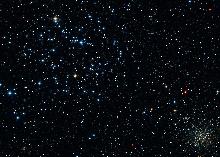
M35 and NGC 2158
This wonderful image was taken by Fritz Benedict and David Chappell using a 30" telescope at McDonal Observatory. Randy Whited combined the three colour CCD images to make the picture
M35 is an open star cluster comprising several hundred stars around a hundred of which are brighter than magnitude 13 and so will be seen under dark skies with a relativly small telescope. It is easily spotted with binoculars close to the "foot" of the upper right twin. A small telescope at low power using a wide field eyepiece will show it at its best. Those using larger telescopes - say 8 to 10 inches - will spot a smaller compact cluster NGC 2158 close by. NGC 2158 is four times more distant that M35 and ten times older, so the hotter blue stars will have reached the end of their lives leaving only the longer-lived yellow stars like our Sun to dominate its light.
To the lower right of the constellation lies the Planetary Nebula NGC2392. As the Hubble Space Telescope image shows, it resembles a head surrounded by the fur collar of a parka hood - hence its other name The Eskimo Nebula. The white dwarf remnant is seen at the centre of the "head". The Nebula was discovered by William Herschel in 1787. It lies about 5000 light years away from us.
The constellation Leo
The constellation Leo is now in the south-eastern sky in the evening. One of the few constellations that genuinely resembles its name, it looks likes one of the Lions in Trafalger Square, with its main and head forming an arc (called the Sickle) to the upper right, with Regulus in the position of its right knee. Regulus is a blue-white star, five times bigger than the sun at a distance of 90 light years. It shines at magnitude 1.4. Algieba, which forms the base of the neck, is the second brightest star in Leo at magnitude 1.9. With a telescope it resolves into one of the most magnificent double stars in the sky - a pair of golden yellow stars! They orbit their common centre of gravity every 600 years. This lovely pair of orange giants are 170 light years away.
Leo also hosts two pairs of Messier galaxies which lie beneath its belly. The first pair lie about 9 degrees to the west of Regulus and comprise M95 (to the east) and M96. They are almost exactly at the same declination as Regulus so, using an equatorial mount, centre on Regulus, lock the declination axis and sweep towards the west 9 degrees. They are both close to 9th magnitude and may bee seen together with a telescope at low power or individually at higher powers. M65 is a type Sa spiral lying at a distance of 35 millin klight years and M66, considerably bigger than M65, is of type Sb. Type Sa spirals have large nuclei and very tightly wound spiral arms whilst as one moves through type Sb to Sc, the nucleus becomes smaller and the arms more open.
The second pair of galaxies, M95 and M96, lie a further 7 degrees to the west between the stars Upsilon and Iota Leonis. M95 is a barred spiral of type SBb. It lies at a distance of 38 million light years and is magnitude 9.7. M96, a type Sa galaxy, is slightly further away at 41 million light years, but a little brighter with a magnitude of 9.2. Both are members of the Leo I group of galaxies and are visible together with a telescope at low power.
There is a further ~9th magnitude galaxy in Leo which, surprisingly, is in neither the Messier or Caldwell catalogues. It lies a little below lambda Leonis and was discovered by William Herschel. No 2903 in the New General Catalogue, it is a beautiful type Sb galaxy which is seen at somewhat of an oblique angle. It lies at a distance of 20.5 million light years.
The constellation Virgo
Virgo, rising in the east in late evening this month, is not one of the most prominent constellations, containing only one bright star, Spica, but is one of the largest and is very rewarding for those with "rich field" telescopes capable of seeing the many galaxies that lie within its boundaries. Spica is, in fact, an exceedingly close double star with the two B type stars orbiting each other every 4 days. Their total luminosity is 2000 times that of our Sun. In the upper right hand quadrant of Virgo lies the centre of the Virgo Cluster of galaxies. There are 13 galaxies in the Messier catalogue in this region, all of which can be seen with a small telescope. The brightest is the giant elliptical galaxy, M87, with a jet extending from its centre where there is almost certainly a massive black hole into which dust and gas are falling. This releases great amounts of energy which powers particles to reach speeds close to the speed of light forming the jet we see. M87 is also called VIRGO A as it is a very strong radio source.
Below Porrima and to the right of Spica lies M104, an 8th magnitude spiral galaxy about 30 million light years away from us. Its spiral arms are edge on to us so in a small telescope it appears as an elliptical galaxy. It is also known as the Sombrero Galaxy as it looks like a wide brimmed hat in long exposure photographs.
The constellation Ursa Major
The stars of the Plough, shown linked by the thicker lines in the chart above, form one of the most recognised star patterns in the sky. Also called the Big Dipper, after the soup ladles used by farmer's wives in America to serve soup to the farm workers at lunchtime, it forms part of the Great Bear constellation - not quite so easy to make out! The stars Merak and Dubhe form the pointers which will lead you to the Pole Star, and hence find North. The stars Alcor and Mizar form a naked eye double which repays observation in a small telescope as Mizar is then shown to be an easily resolved double star. A fainter reddish star forms a triangle with Alcor and Mizar.
Ursa Major contains many interesting "deep sky" objects. The brightest, listed in Messier's Catalogue, are shown on the chart, but there are many fainter galaxies in the region too. In the upper right of the constellation are a pair of interacting galaxies M81 and M82 shown in the image below. M82 is undergoing a major burst of star formation and hence called a "starburst galaxy". They can be seen together using a low power eyepiece on a small telescope.
Another, and very beautiful, galaxy is M101 which looks rather like a pinwheel firework, hence its other name the Pinwheel Galaxy. It was discovered in1781 and was a late entry to Messier's calalogue of nebulous objects. It is a type Sc spiral galaxy seen face on which is at a distance of about 24 million light years. Type Sc galaxies have a relativly small nucleus and open spiral arms. With an overall diameter of 170,000 light it is one of the largest spirals known (the Milky Way has a diameter of ~ 130,000 light years).
Though just outside the constellation boundary, M51 lies close to Alkaid, the leftmost star of the Plough. Also called the Whirlpool Galaxy it is being deformed by the passage of the smaller galaxy on the left. This is now gravitationally captured by M51 and the two will eventually merge. M51 lies at a distance of about 37 million light years and was the first galaxy in which spiral arms were seen. It was discovered by Charles Messier in 1773 and the spiral structure was observed by Lord Rosse in 1845 using the 72" reflector at Birr Castle in Ireland - for many years the largest telescope in the world.
Lying close to Merak is the planetary nebula M97 which is usually called the Owl Nebula due to its resemblance to an owl's face with two large eyes. It was first called this by Lord Rosse who drew it in 1848 - as shown in the image below right. Planetary nebulae ar the remnants of stars similar in size to our Sun. When all possible nuclear fusion processes are complete, the central core collpses down into a "white dwarf" star and the the outer parts of the star are blown off to form the surrounding nebula.


